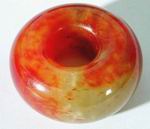
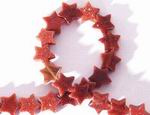

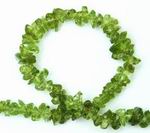
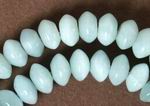
Summer Peridot, Onyx,
Flaked Stone, Donut Beads & More!
You have received this newsletter because you opted after a past purchase, but should you wish to be taken off the mailing list, just click the link at the bottom. This month is the August gemstone peridot, along with sardonyx, onyx, flaked stones, amazonite, and donut beads. Scroll down, or click one of the links below on the html version to go to a certain section. If you have any suggestions for the future, please e-mail me at suggestions@mrbead.com.
If you weren't mailed this newsletter enter your e-mail address
here to receive next month's newsletter
Peridot – the gemstone for August
Pearl & Peridot Necklace
Sardonyx & Onyx – alternate stone for August
Flaked Stones
Amazonite
Donut Beads look Great!
Beads Used to be Money!
All I
Really Bead To Know I Learned From Beading!
Special $10 Offer !
Peridot – the gemstone for August
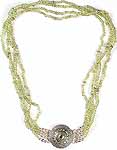
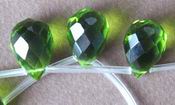
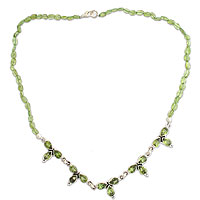
The vivid, slightly golden shimmering green of Peridot is the ideal gemstone color to complement a light summertime outfit. Peridot (pronounced pair-a-doe) is the gem variety of olivine, a mineral formed under intense heat. Perhaps named from the French word “Peridot” meaning unclear, due to its inclusions and cloudy nature. Small crystals of peridot are often found in rocks by volcanoes and in meteors. Because the iron which creates the color is an integral part of its structure, its color is always green - ranging from transparent lime to olive green. One of the few gemstones of only in one color.
Peridot has been mined as a gemstone for thousands of years, said to be the favorite gem of Cleopatra, and mentioned in the Bible. In ancient Egypt it was mined at night because legend tells that peridot was hard to see during the day, yet easily visible by lamplight. The Greeks and Romans called peridot “topazion” and “topazius” - the later named topaz, to end the confusion between the two. Peridot has also been confused with emerald and many jewelers refer to it as "evening emerald". Peridot was later used to decorate medieval churches, carried back to Europe by the Crusaders, like the huge stones of more than 200 carats in size at Cologne Cathedral.


 The gemstone is actually known under three names: Peridot,
Chrysolith (derived from the Greek word “goldstone”) and Olivin, because Peridot
is the gemstone variety of the Olivin mineral. In the gemstone trade it is
generally called Peridot, a name derived from the Greek “peridona”, meaning
something like “giving plenty.
The gemstone is actually known under three names: Peridot,
Chrysolith (derived from the Greek word “goldstone”) and Olivin, because Peridot
is the gemstone variety of the Olivin mineral. In the gemstone trade it is
generally called Peridot, a name derived from the Greek “peridona”, meaning
something like “giving plenty.
Peridot is recommended for insomnia, digestive problems and to stimulate the mind. Some say peridot has the power to drive away evil spirits, intensified when the stone is set in gold. And it’s also said to strengthen the power of any medicine drunk from peridot goblets. Peridot is for people with the star sign of Leo. top of page
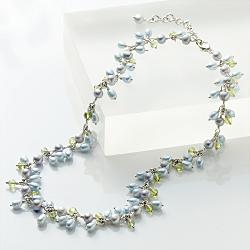
Teardrops of the moon goddess! This necklace is to inspire what can be done using a combination of different stones. Blue pearls with vivid green peridot make a striking fresh combination to cool you from the summer heat. Clusters of pale-blue 7mm rice pearls are wrapped with 4mm peridot beads producing this 16" -18" long necklace with a lobster clasp. top of page
Sardonyx & Onyx – alternate stone for August
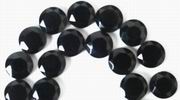

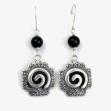
You need onyx beads for the same reason you have so many black clothes - you can wear it with anything! Onyx mixes well with other colors too. Being unobtrusive, allowing other brilliantly colored gemstones to shine. Yet at the same time, when onyx is highly polished and nicely faceted, this stone demands attention on its own.
Although onyx is one of the more recognized stones, nearly all stones sold as "black onyx" are actually color enhanced chalcedony. Which is not so bad as onyx is a member of the agate-chalcedony family, just like carnelian. Stones sold as "banded onyx" with swirls and curving bands of white are also color enhanced agates. In fact you can pretty much assume that all onyx sold today is color enhanced. True onyx has alternating bands of black and white layers that are pretty straight.

 The
coloring process used to turn chalcedony into black onyx is rather interesting.
Natural chalcedonies are first soaked in a concentrated sugar solution, and then
heated in sulfuric acid. Just like when you are cooking with sugar, the heat
carbonizes the sugar soaked up into the porous stone and turns it into the
beloved black color. Thanks to this technique, onyx is now readily available
and affordable.
The
coloring process used to turn chalcedony into black onyx is rather interesting.
Natural chalcedonies are first soaked in a concentrated sugar solution, and then
heated in sulfuric acid. Just like when you are cooking with sugar, the heat
carbonizes the sugar soaked up into the porous stone and turns it into the
beloved black color. Thanks to this technique, onyx is now readily available
and affordable.
Onyx looks bold and sexy when combined with red beads. It tones down a colorful necklace that might other wise look garish, yet prevents pastel projects from appearing bubblegum sweet. Onyx is also fantastic with stones that have black inclusions, like tourmalated quartz and Peruvian opal. The black of the onyx stops the inclusions from being a distracting flaw by turning them into bridges that allow the viewer to keep their eyes moving over the necklace. Faceted onyx adds sophistication to your designs, while smooth onyx inserts a sleek and modern touch. And onyx with pearls creates very elegant jewelry. Onyx‘s versatility gives it limitless possibility mixed with other stones, so it's a good idea to always have a few onyx beads handy.
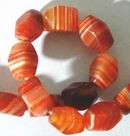
Sardonyx is onyx with white and red-brown bands- named from
the Greek, “Sard” meaning "reddish brown," and onyx meaning "veined gem”.
Sardonyx
 at
one time was more precious than gold, silver, or sapphire! Roman soldiers wore
sardonyx talismans engraved with heroes such as Hercules or Mars, god of war.
They believed that the stone would make the wearer as brave and daring as the
figured carved on it. And during the Renaissance, sardonyx was thought to
greatly help public speakers.
at
one time was more precious than gold, silver, or sapphire! Roman soldiers wore
sardonyx talismans engraved with heroes such as Hercules or Mars, god of war.
They believed that the stone would make the wearer as brave and daring as the
figured carved on it. And during the Renaissance, sardonyx was thought to
greatly help public speakers.
Onyx has been used to strengthen the heart, kidneys, nerves, hair, eyes and
nails; while sharpening the wits, controlling emotions, inspiring spirituality
and aiding sleep. Also said to eliminate negative thoughts, apathy, stress and
neurological disorders – and black Onyx is used to help change habits.
Care and treatment: Onyx may chip or scratch rather easily, so store onyx carefully and never allow two specimens to touch each other. top of page
The most common flaked stone is goldstone. A manmade material first created by alchemists trying to make gold. Other variations are bluestone, lemon stone, and peach stone. Each are a type of glass mixed with metals to form a glittery appearance.
Goldstone has tiny specks of copper dispersed all over them. Bluestone beautifully captures the essence of twinkling stars with its dark purple sparkles. There are also brick-red and greenstones with a similar shimmering look. The red varieties were created to look like sunstone, a member of feldspar, and the greenstones look a little like sparkling aventurine.
Although manmade, they do have metaphysical properties - these are transmitter stones. Warn as jewelry, flaked stone causes light to pass through you in order to receive a medium. Revitalizing, energizing, and bringing a positive attitude and individualism. As well as calming, refreshing, and is said to protect the center of the body reducing stomach tension. The tiny copper particles also increase blood flow and stabilize your energies and emotions. Plus, their starry appearance will remind you to reach for the stars and that there’s light within the darkness.
These stones are ideal for evening wear. Bluestone goes well with dark amethyst, and you’ll feel like you’re wearing little drops of midnight sky! Goldstone is like rays of sunshine, while redstone is fantastic with carnelian and jaspers. top of page
Amazonite is named after the Amazon River – hence its other name “Amazon Jade”. However, despite ideas that the river was the source of amazonite, no deposits have ever been found nearby in Brazil. The green stone of legend was probably nephrite, which is found in the area. Similar-looking stones such like jadeite and turquoise have also been confused with amazonite.

 Amazonite is blue-green colored microcline, sometimes with
white and/or yellow bands - the only kind of microcline considered suitable for
jewelry. Small amounts of lead and water give amazonite its color, though it
was once thought to thought to be copper. Amazonite is one of the oldest-used gemstones, with vases
and engravings found from ancient Egypt and Sri Lanka. Some believe amazonite
to have positive effects on ones mood, and can bring healthy skin. An elixir of
amazonite is thought by some to rectify calcium deficiencies.
top of page
Amazonite is blue-green colored microcline, sometimes with
white and/or yellow bands - the only kind of microcline considered suitable for
jewelry. Small amounts of lead and water give amazonite its color, though it
was once thought to thought to be copper. Amazonite is one of the oldest-used gemstones, with vases
and engravings found from ancient Egypt and Sri Lanka. Some believe amazonite
to have positive effects on ones mood, and can bring healthy skin. An elixir of
amazonite is thought by some to rectify calcium deficiencies.
top of page
Donut beads are great for focusing attention on a necklace, they also look good used for matching earrings too. With a little imagination you can even make them into a bracelet. If you want to hide the wire running through the middle of the donut hole, don’t use a wire at all - link the donut bead by using head pins. Just insert a head pin into each of the bead holes from the inner edge and then loop the ends poking out on the outer edge.
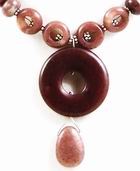

![]() Similarly, you could also hang a briolette from a donut bead like the
necklace shown left. First, thread a briolette onto a piece of rigid wire and
bring the ends together like you normally would when you are making a briolette
drop. Next, insert the wire ends through one of the bead holes from the outside
edge into the donut hole, and then cut off the extra wire, leaving about a
quarter of an inch. Finally, fold the leftover wire and create a nub so that the
drop won’t slip out of the donut bead. Finally, smaller donut beads can be
strung together making a spectacular necklace.
Similarly, you could also hang a briolette from a donut bead like the
necklace shown left. First, thread a briolette onto a piece of rigid wire and
bring the ends together like you normally would when you are making a briolette
drop. Next, insert the wire ends through one of the bead holes from the outside
edge into the donut hole, and then cut off the extra wire, leaving about a
quarter of an inch. Finally, fold the leftover wire and create a nub so that the
drop won’t slip out of the donut bead. Finally, smaller donut beads can be
strung together making a spectacular necklace.
Beads used to be Money!
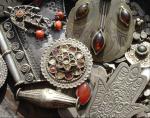
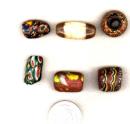

For thousands of years, beads have played an important role throughout every
corner of the globe. They have been used as a medium of trade, as talismans, as
jewelry, as status symbols, and for religion. Beads can be found almost as far
back in history as humans themselves. The oldest known beads were from the
Neanderthal people, dating back to around 38,000 BC in France. These were made
from animal teeth and bone. Beads serve as capsules of culture, history, and
technology. It is difficult to imagine counting without numbers, but until
numbers were invented, counting devices were used for everyday calculations.
Like 300 BC counting boards and the Chinese abacus from around 1200 A.D.
top of page
 All I Really Bead To Know
I Learned From Beading!
All I Really Bead To Know
I Learned From Beading!


By Leri Jacobs
1. Share your beads.
2. Go to bead fairs.
3. Don't break your beads.
4. Put your beads back in the right containers.
5. Clean your glasses (so you can see your beads) .
6. Don't steal others beads.
7. Make amends by giving beads.
8. Wax your string before you bead.
9. Bead.
10. A bright light and a magnifying glass are good for you.
11. Live a beaded life: bead, bead, eat, sleep, bead.
12. Bead every afternoon.
Special $10 Offer !
Sample our beads with $10 discount off any order in our MrBead bead store, just key in
"onyx" at the checkout (without the inverted commas) and click "Redeem
Coupon". Cannot be used with any other coupon.
Offer valid until 10th August only - so act now! Only for use in our store at the checkout and not valid with any other offers. We like to mail fast, but I have to warn you that there may be a slight delay on some orders made between now and early-August because of our holiday backlog. E-mail to check if you need your beads fast over this time!
For our exclusive peridot section click here
For our Onyx section click here
For our Sardonyx key in the search here
For our Flaked Stone click here
For our Amazonite click here
Donut Beads click
here
To see our bead store at
MrBead click http://www.mrbead.com
To return to the top click here